
- Poems Poetry Art
- Author
- Alfred French (11)
- Charles Bukowski (12)
- Clarence F Underwood (6)
- Edgar Allan Poe (16)
- Edmund Spenser (7)
- Eyvind Earle (15)
- Jack Hirschman (16)
- John Hejduk (9)
- John Milton (7)
- Lance Woolaver (7)
- Lindley Murray (8)
- Patti Smith (16)
- Reilly Rhodes (11)
- Rosaleen Norton (6)
- Shel Silverstein (9)
- Unknown (9)
- Various (40)
- William Blake (9)
- William Shakespeare (7)
- Wulf Segebrecht (17)
- ... (3209)
- Binding
- Language
- Arabic (3)
- Czech & English (11)
- Dutch (5)
- Eng, Gec (3)
- English (1340)
- English, Japanese (3)
- English, Persian (3)
- English, Russian (9)
- French (43)
- Germ, German (4)
- German (45)
- German, Germ (12)
- Hebrew (3)
- Italian (11)
- Japanese (18)
- Latin (11)
- Persian (7)
- Portuguese (3)
- Russian (19)
- Spanish (13)
- ... (1881)
- Publisher
- Abrams, Inc. (12)
- Bernard Lintott (6)
- Brill (6)
- Broadside Press (10)
- De Selliers, Diane (10)
- E. Little & Co (8)
- George Olms (16)
- Gotham Press (9)
- Hard Press (15)
- Harpercollins (7)
- J.b. Metzlersche (17)
- Museum Of Modern Art (9)
- Nimbus Publishing (7)
- Rizzoli (9)
- Samuel French (7)
- Sore Dover Press (7)
- Ten Crow Press (6)
- Thames & Hudson (6)
- Unknown (11)
- X-ray Book Company (6)
- ... (3263)
- Region
- Signed
Negro Songs Of Protest Russian Avant Garde Book Elie Siegmeister Moscow 1964
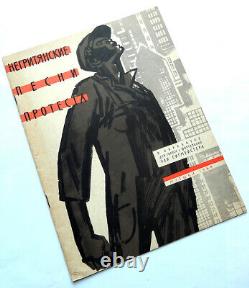
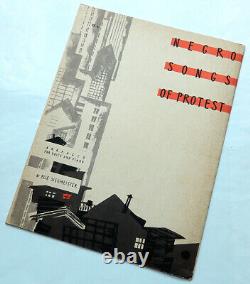
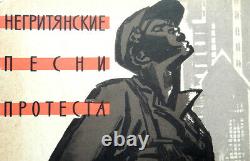
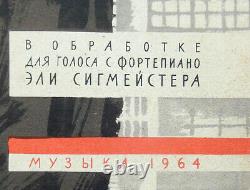
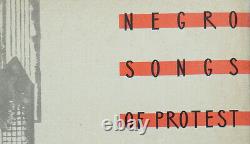
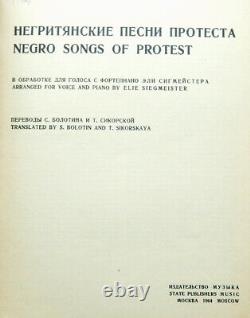
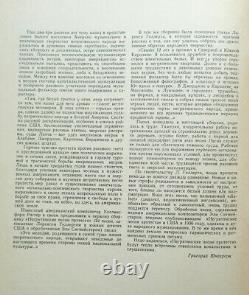
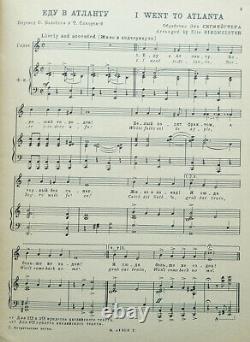
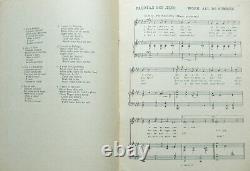

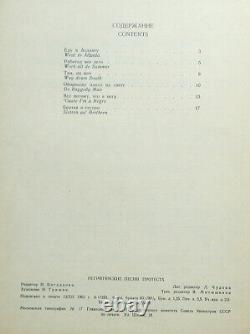


NEGRO SONGS OF PROTEST RUSSIAN AVANT GARDE BOOK ELIE SIEGMEISTER MOSCOW 1964. NEGRO SONGS OF PROTEST Arranged for Voice and Piano. Published by State Publishers Music.
Printed in Moscow in 1964. Amazing avant garde illustrated cover by the Artist N. The book contains the songs I went to Atlanta , Work all de summer, Way down South, De raggedy man, Cause I'm a Negro and Sistren an' brethren.
This EXTREMELY RARE book was printed in 1100 copies. Worldcat listed only the Polish edition (One copy in Warsaw library), the Russian edition not appeared in any library worldwide!! Size:11.5x8.75 inch, 29x22cm. Please have a look at my other listings. The items here represent only a portion of Yale's holdings in Yiddish literature. The Beinecke, in collaboration with the Yale University library Judaica Collection, continues to digitize and make Yiddish books available online. With the Russian Revolution of 1917, prohibitions on Yiddish printing imposed by the Czarist regime were lifted. Thus, the early post-revolutionary period saw a major flourishing of Yiddish books and journals. The new freedoms also enabled the development of a new and radically modern art by the Russian avant-garde. Artists such as Mark Chagall, Joseph Chaikov, Issachar Ber Ryback, El (Eliezer) Lisitzsky and others found in the freewheeling artistic climate of those years an opportunity Jews had never enjoyed before in Russia: an opportunity to express themselves as both Modernists and as Jews. Their art often focused on the small towns of Russia and Ukraine where most of them had originated. Their depiction of that milieu, however, was new and different. Jewish art in the early post-revolutionary years emerged with the creation of a secular, socialist culture and was especially cultivated by the Kultur-Lige, the Jewish social and cultural organizations of the 1920s and 1930s. One of the founders of the first Kultur-Lige in Kiev in 1918 was Joseph Chaikov, a painter and sculptor whose books are represented in the Beinecke's collection. The Kultur-Lige supported education for children and adults in Jewish literature, the theater and the arts. The organization sponsored art exhibitions and art classes and also published books written by the Yiddish language's most accomplished authors and poets and illustrated by artists who in time became trail blazers in modernist circles. This brief flowering of Yiddish secular culture in Russia came to an end in the 1920s. As the power of the Soviet state grew under Stalin, official culture became hostile to the experimental art that the revolution had at first facilitated and even encouraged. Many artists left for Berlin, Paris and other intellectual centers. Those that remained, like El Lisitzky, ceased creating art with Jewish themes and focused their work on furthering the aims of Communism. Tragically, many of them perished in Stalin's murderous purges. He was one of the most important figures of the Russian avant-garde, helping develop Suprematism with his friend and mentor, Kazimir Malevich. He began his career illustrating Yiddish children's books in an effort to promote Jewish culture. In 1921, he became the Russian cultural ambassador in Weimar Germany, working with and influencing important figures of the Bauhaus movement.He brought significant innovation and change to the fields of typography, exhibition design, photomontage, and book design, producing critically respected works and winning international acclaim. However, as he grew more involved with creating art work for the Soviet state, he ceased creating art with Jewish themes.
Among the best known Yiddish books illustrated by the artist is Sikhes Hulin by the writer and poet Moshe Broderzon and Yingel Tsingle Khvat, a children's book of poetry by Mani Leyb. Both works have been completely digitized and can be found here.
Born in Kiev, Chaikov studied in Paris from 1910 to 1913. Returning to Russia in 1914, he became active in Jewish art circles and in 1918 was one of the founders of the Kultur-Lige in Kiev. Though primarily known as a sculptor, in his early career, he also illustrated Yiddish books, many of them children's books.
In 1921 his Yiddish book, Skulptur was published. In it, the artist formulated an avant-garde approach to sculpture and its place in a new Jewish art.
It too is in the Beinecke collection. Another of the great artists from this remarkable period in Yiddish cultural history is Issachar Ber Ryback. Together with Lisistzky, he traveled as a young man in the Russian countryside studying Jewish folk life and art. Their findings made a deep impression on both men as artists and as Jews and folk art remained an abiding influence on their work. One of Ryback's better known works is Shtetl, Mayn Khoyever heym; a gedenknish (Shtetl, My destroyed home; A Remembrance), Berlin, 1922.
In this book, also in the Beinecke collection, the artist depicts scenes of Jewish life in his shtetl (village) in Ukraine before it was destroyed in the pogroms which followed the end of World War I. Indeed, Shtetl is an elegy to that world. David Hofstein's book of poems, Troyer (Tears), illustrated by Mark Chagall also mourns the victims of the pogroms. It was published by the Kultur-Lige in Kiev in 1922. Chagall's art in this book is stark and minimalist in keeping with the grim subject of the poetry.Chagall was a leading force in the new emerging Yiddish secular art and many of the young modernist artists of the time came to study and paint with him in Vitebsk, his hometown. Lisistzky and Ryback were among them. Chagall, however, parted ways with them when their artistic styles and goals diverged. Chagall moved to Moscow in 1920 where he became involved with the newly created and innovative Moscow Yiddish Theater. Cite as: General Modern Collection, Beinecke Rare Book and Manuscript Library, Yale University KULTUR LIGE : the Kultur Lige was at the heart of the Jewish cultural renaissance in Kiev, providing education and culture to the Jewish population.
It had its own press, which published teaching material, literary and historical studies, literary journals, and children's books such as Troyer. The artists involved included Lissitzky, Ryback, Chagall, and Tchaikov, to name only a few. The exhibition "Kultur-Lige: Artistic Avant-Garde of 1910-s - 1920s" occured on December 20, 2007 - January 25, 2008 in the National Museum of Art of Ukraine.It was dedicated to the activity of artistic section of enlightenment organization Kultur-Lige (Cultural-League), which was active on the territory of Ukraine in the first half of 20-s - beginning of 30-s of XX century. In the exposition works of Mark Chagall, Alexander Tyshler, Mark Epstein, Elieser Lisitski, Josef Chaikov, Abraham Manevich, Issakhar-Ber Rybak, Boris Aronson, Nathan Altman, Solomon Nikritin and Sarah Shor were represented. 1910- 1920 is the period of Jewish life transformation.
New Jewish culture was formed through dramatic events. Studying and trying to understand a phenomenon of Jewish life and Jewish culture development in Kyiv and Ukraine and also "Kultur-Lige" activities in the context of the epoch are of a crucial importance. It is necessary for understanding of Jewish history and culture of entire Eastern Europe. Mikhail Karasik is a leader within the movement in art that is known as the artist's book.
It could even be said that in Russia, the phenomenon that is the artist's book is inseparably linked to his name, and that without his efforts it would be impossible to imagine it in its present form. In this context, Karasik fulfills numerous functions: a leading author, the key ideologist, a tireless organizer, a successful publisher, an active curator, a talented propagandist and a skilful promoter, as well as performing many other roles. His efforts are largely responsible for the steady stream of success enjoyed by this particular form of art over the past decade.Karasik curated three Paper Theatre exhibitions, demonstrating the independent and important role of artist's book from St Petersburg in modern art. These shows helped to define the circle of authors, typology of the publications and the main tendencies and passions. A «representative» literature also appeared - catalogues with numerous articles and detailed descriptions of the exhibits.
We should also recall the Kharms-Festivals, the Kharmsizdat conferences and produce. Mikhail Karasik was the initiator of all these and many other exciting projects.The artist's works have been acquired by some of the of the world's leading libraries and museums. Karasik regularly contributes to international projects, special actions and fairs. The Western image of the modern Russian artist's book is, to a large extent, synonymous with his name and work. This does not imply, however, that Karasik is only interested in self- representation. He is an active promoter of Russian artist's books in the West, showing the works of his compatriots at international art salons and book fairs.
Leonid Tishkov Leonid Tishkov's poetic and metaphysic oeuvre is realised in a diverse and often unconventional range of media, including installations, sculpture, video, photography, works on paper and books. Leonid Tishkov started his career making cartoon like works in the 1980s that focused with ironic, black humor and political aspects. Since the beginning of the 1990s, however, his work moved increasingly towards large-scale installations that aimed to engage the viewer into absurdist situations with fictional cartoon characters and an admixture of theatrical action.
This theatrical performances "Dabloids", "Deep Sea Divers", "Living in the Trunks", who after turned into installations ("Dabloid Factory", "Divers" bronze sculptures). At the same time Tishkov drawn to the theme of memory, creates a set of objects, videos and photos about his native place - the Urals and late mother, using different kinds of folk art and found materials - clothing and household utensils ("The Knitling", 2002, "Divers from Heaven", 2004). For the first time made the light object in shape of crescent Moon to the installation for open space, traveled to different countries and continents including Russia, Japan, Singapore, Taiwan, Austria, France and Switzerland. Leonid Tishkov was born into a school teacher's family in small town of Russia, Urals in 1953, and now lives and works in Moscow. Works of artist in collection Museum of Modern Art, NY, USA Nasher Museum of Art, NC, USA Moderna Museet Stockholm, Sweden Contemporary Art Center Uyazdovsky Castle, Warsaw Centro per l'Arte Contemporanea Luigi Pecci, Prato Kaohsiung Museum of Fine Arts, Taiwan Wooyang Museum of Contemporary Art, Korea Art Gallery of Western Australia, Perth Tretyakov Gallery, Moscow National Center for Contemporary Art, Russia Multimedia Art Museum, Moscow Ekaterinburg Museum of Fine Art, Russia Nyzhny Tagil Museum of Fine Art, Russia Krasnoyarsk Museum Center, Russia Moscow Museum of Modern Art, Russia Hermes collection, Paris Klingspor-Museum, Offenbach, Germany The concept of avant-garde refers primarily to artists, writers, composers, and thinkers whose work is opposed to mainstream cultural values, and often has a trenchant social or political edge. Many writers, critics, and theorists made assertions about vanguard culture during the formative years of modernism, although the initial definitive statement on the avant-garde was the essay "Avant-Garde and Kitsch", by New York art critic Clement Greenberg.It was published in Partisan Review in 1939. [17] Greenberg argued that vanguard culture has historically been opposed to "high" or "mainstream" culture, and that it has also rejected the artificially synthesized mass culture that has been produced by industrialization. Each of these media is a direct product of capitalism-they are all now substantial industries-and as such, they are driven by the same profit-fixated motives of other sectors of manufacturing, not the ideals of true art.
For Greenberg, these forms were therefore kitsch - phony, faked, or mechanical culture. Such things often pretended to be more than they were by using formal devices stolen from vanguard culture. For instance, during the 1930s, the advertising industry was quick to take visual mannerisms from surrealism, but this does not mean that 1930s advertising photographs are truly surreal. Max Horkheimer (front left), Theodor Adorno (front right), and Jürgen Habermas in the background, right, in 1965 at Heidelberg, West Germany Similar views were argued by members of the Frankfurt School, the originators of Critical Theory, an approach to social philosophy that focuses on reflective assessment and critique of society and culture in order to reveal and challenge power structures. Theodor Adorno and Max Horkheimer in their essay "The Culture Industry: Enlightenment as Mass-Deception" (1944), and also Walter Benjamin in his highly influential "The Work of Art in the Age of Mechanical Reproduction" 1935, rev. 1939 spoke of mass culture. [18] They indicated that this bogus culture is constantly being manufactured by a newly emerged culture industry (comprising commercial publishing houses, the movie industry, the record industry, and the electronic media).In this way, the autonomous artistic merit, so dear to the vanguardist, was abandoned and sales increasingly became the measure, and justification, of everything. [19] The avant-garde's co-option by the global capitalist market, by neoliberal economies, and by what Guy Debord called The Society of the Spectacle (a seminal text for the Situationist movement describing the "autocratic reign of the market economy"), have made contemporary critics speculate on the possibility of a meaningful avant-garde today.
Paul Mann's Theory-Death of the Avant-Garde demonstrates how completely the avant-garde is embedded within institutional structures today, a thought also pursued by Richard Schechner in his analyses of avant-garde performance. [20] Despite the central arguments of Greenberg, Adorno, and others, various sectors of the mainstream culture industry have co-opted and misapplied the term "avant-garde" since the 1960s, chiefly as a marketing tool to publicise popular music and commercial cinema.It has become common to describe successful rock musicians and celebrated film-makers as "avant-garde", the very word having been stripped of its proper meaning. Noting this important conceptual shift, major contemporary theorists such as Matei Calinescu in Five Faces of Modernity: Modernism, Avant-garde, Decadence, Kitsch, Postmodernism (1987), [page needed] and Hans Bertens in The Idea of the Postmodern: A History (1995), [page needed] have suggested that this is a sign our culture has entered a new post-modern age, when the former modernist ways of thinking and behaving have been rendered redundant.
[21] Nevertheless, an incisive critique of vanguardism as against the views of mainstream society was offered by the New York critic Harold Rosenberg in the late 1960s. [22] Trying to strike a balance between the insights of Renato Poggioli and the claims of Clement Greenberg, Rosenberg suggested that, from the mid-1960s onward, progressive culture ceased to fulfill its former adversarial role. Since then it has been flanked by what he called "avant-garde ghosts to the one side, and a changing mass culture on the other", both of which it interacts with to varying degrees. This has seen culture become, in his words, a profession one of whose aspects is the pretense of overthrowing it. [23] Avant-garde is frequently defined in contrast to arrière-garde, which in its original military sense refers to a rearguard force that protects the advance-guard. [24] The term was less frequently used than "avant-garde" in 20th-century art criticism. [25] The art historians Natalie Adamson and Toby Norris argue that arrière-garde is not reducible to a kitsch style or reactionary orientation, but can instead be used to refer to artists who engage with the legacy of the avant-garde while maintaining an awareness that doing so is in some sense anachronistic. [26] The critic Charles Altieri argues that avant-garde and arrière-garde are interdependent: where there is an avant-garde, there must be an arrière-garde. [27] Examples Music Main article: Avant-garde music Avant-garde in music can refer to any form of music working within traditional structures while seeking to breach boundaries in some manner. [28] The term is used loosely to describe the work of any musicians who radically depart from tradition altogether. [29] By this definition, some avant-garde composers of the 20th century include Arnold Schoenberg, [30] Richard Strauss (in his earliest work), [31] Charles Ives, [32] Igor Stravinsky, [30] Anton Webern, [33] Edgard Varèse, Alban Berg, [33] George Antheil (in his earliest works only), Henry Cowell (in his earliest works), Harry Partch, John Cage, Iannis Xenakis, [30] Morton Feldman, Karlheinz Stockhausen, [34] Pauline Oliveros, [35] Philip Glass, Meredith Monk, [35] Laurie Anderson, [35] and Diamanda Galás. [35] There is another definition of "Avant-gardism" that distinguishes it from "modernism":Peter Bürger, for example, says avant-gardism rejects the "institution of art" and challenges social and artistic values, and so necessarily involves political, social, and cultural factors. [29] According to the composer and musicologist Larry Sitsky, modernist composers from the early 20th century who do not qualify as avant-gardists include Arnold Schoenberg, Anton Webern, and Igor Stravinsky; later modernist composers who do not fall into the category of avant-gardists include Elliott Carter, Milton Babbitt, György Ligeti, Witold Lutoslawski, and Luciano Berio, since their modernism was not conceived for the purpose of goading an audience. [36] The 1960s saw a wave of free and avant-garde music in jazz genre, embodied by artists such as Ornette Coleman, Sun Ra, Albert Ayler, Archie Shepp, John Coltrane and Miles Davis.[37][38] In the rock music of the 1970s, the "art" descriptor was generally understood to mean "aggressively avant-garde" or "pretentiously progressive". [39] Post-punk artists from the late 1970s rejected traditional rock sensibilities in favor of an avant-garde aesthetic. Theatre Main article: Experimental theatre Whereas the avant-garde has a significant history in 20th-century music, it is more pronounced in theatre and performance art, and often in conjunction with music and sound design innovations, as well as developments in visual media design. There are movements in theatre history that are characterized by their contributions to the avant-garde traditions in both the United States and Europe.
Among these are Fluxus, Happenings, and Neo-Dada. Art movements Abstract expressionism Artivism COBRA Conceptual art Constructivism Cubism Dadaism De Stijl Expressionism Fauvism Fluxus Futurism Happening Imaginism Imagism Impressionism Incoherents Land art Les Nabis Lyrical Abstraction Minimal art Neo-Dada Orphism Pop art Precisionism Primitivism Rayonism Situationism Suprematism Surrealism Symbolism Tachisme Universal Constructivism Viennese Actionism Vorticism Creationism Nadaism Stridentism Ultraist. This item is in the category "Books & Magazines\Antiquarian & Collectible". The seller is "levant-fair" and is located in this country: IL. This item can be shipped worldwide.
- Year Printed: 1964
- Country/Region of Manufacture: Russian Federation
- Topic: Poetry
- Binding: Softcover, Wraps
- Region: Europe
- Subject: Art & Photography
- Original/Facsimile: Original
- Language: Russian
- Place of Publication: Moscow
- Special Attributes: 1st Edition, Illustrated, Limited Edition

